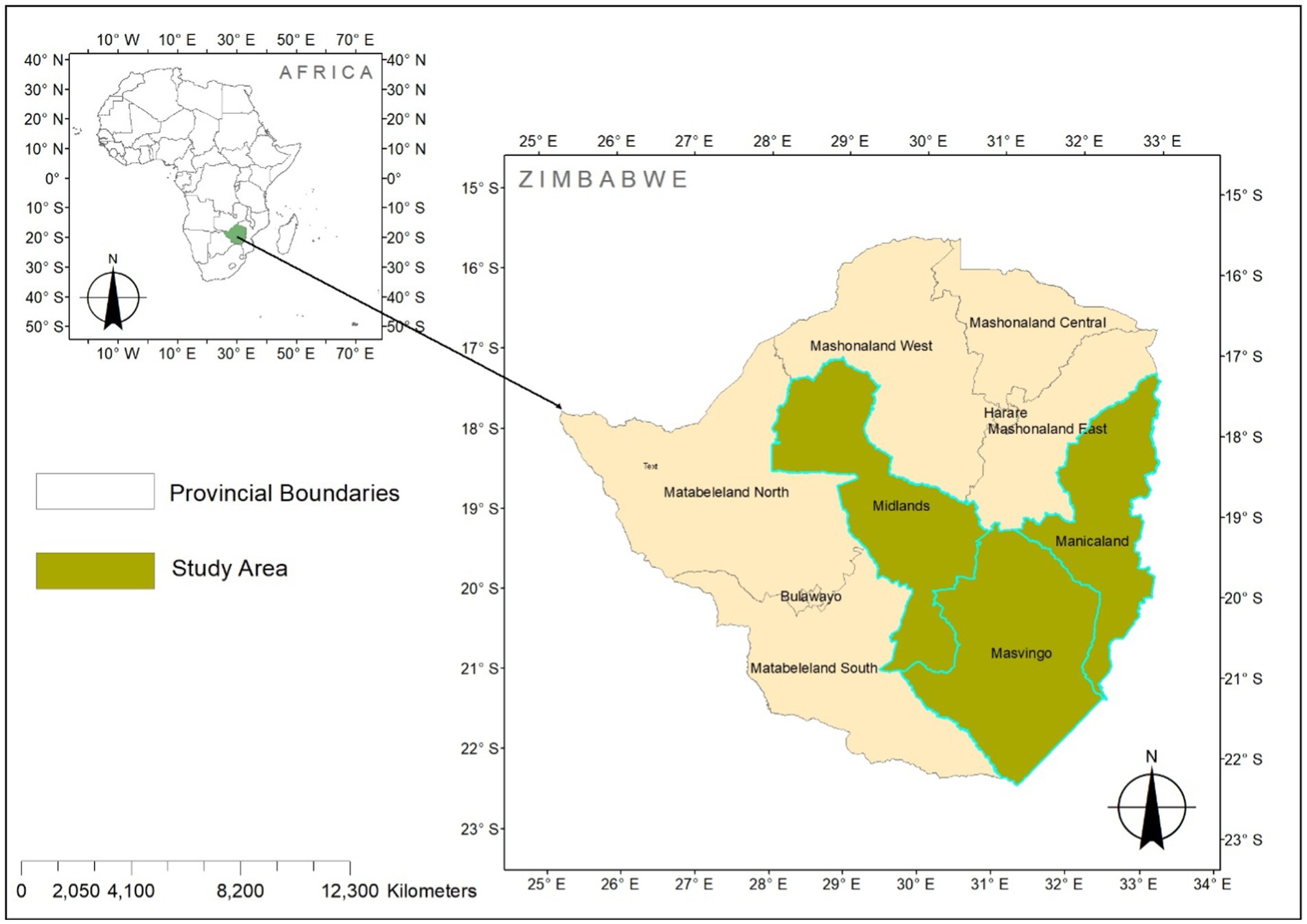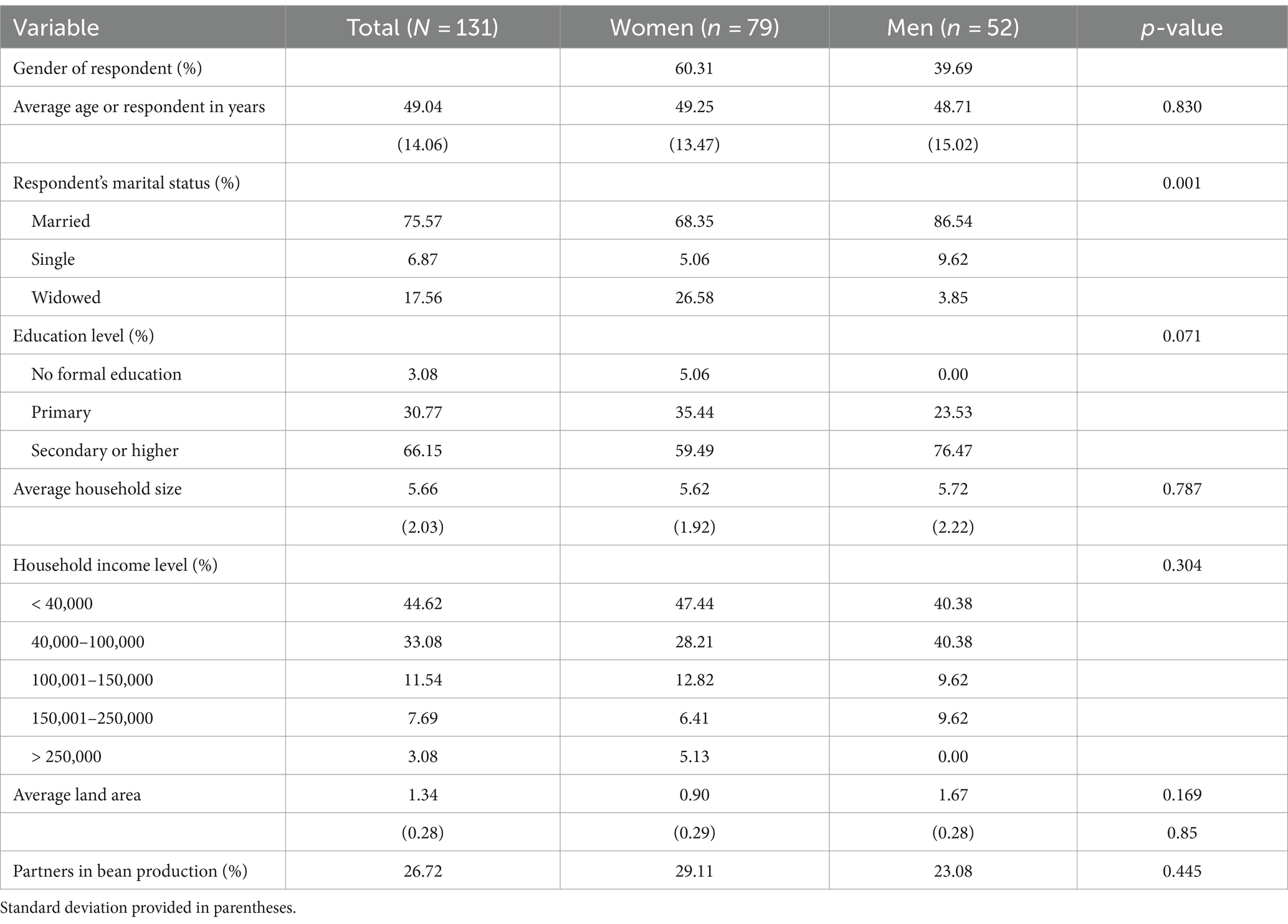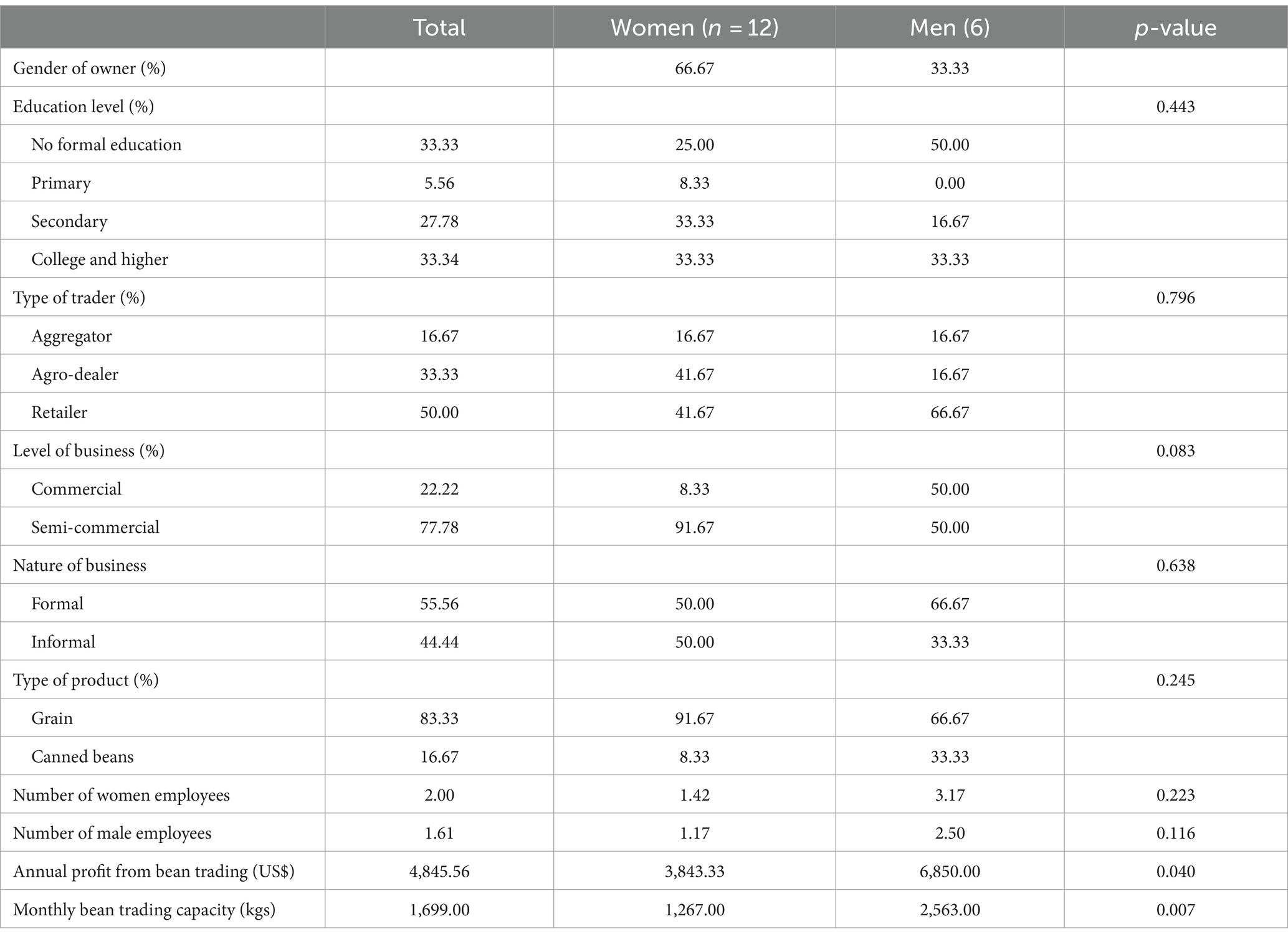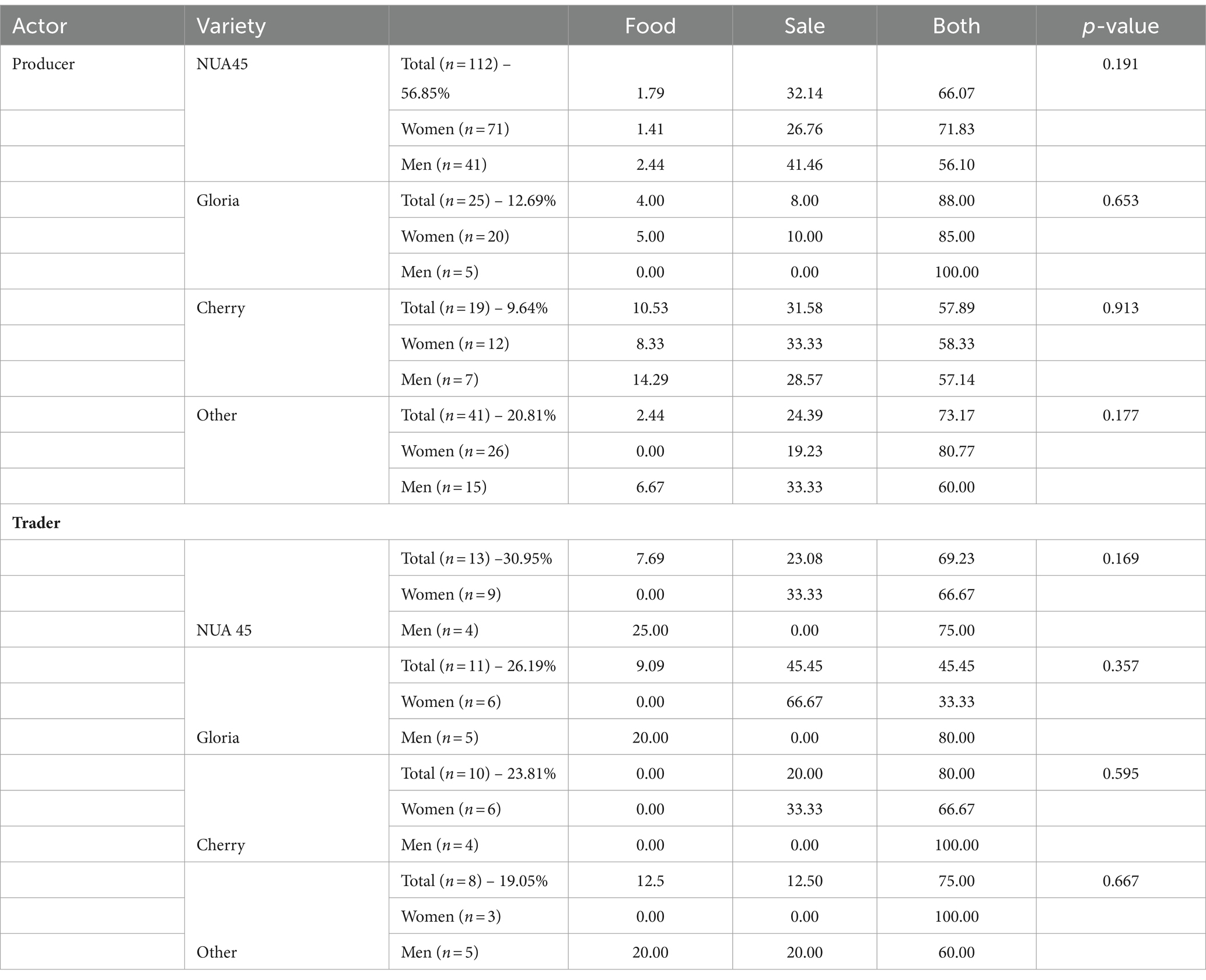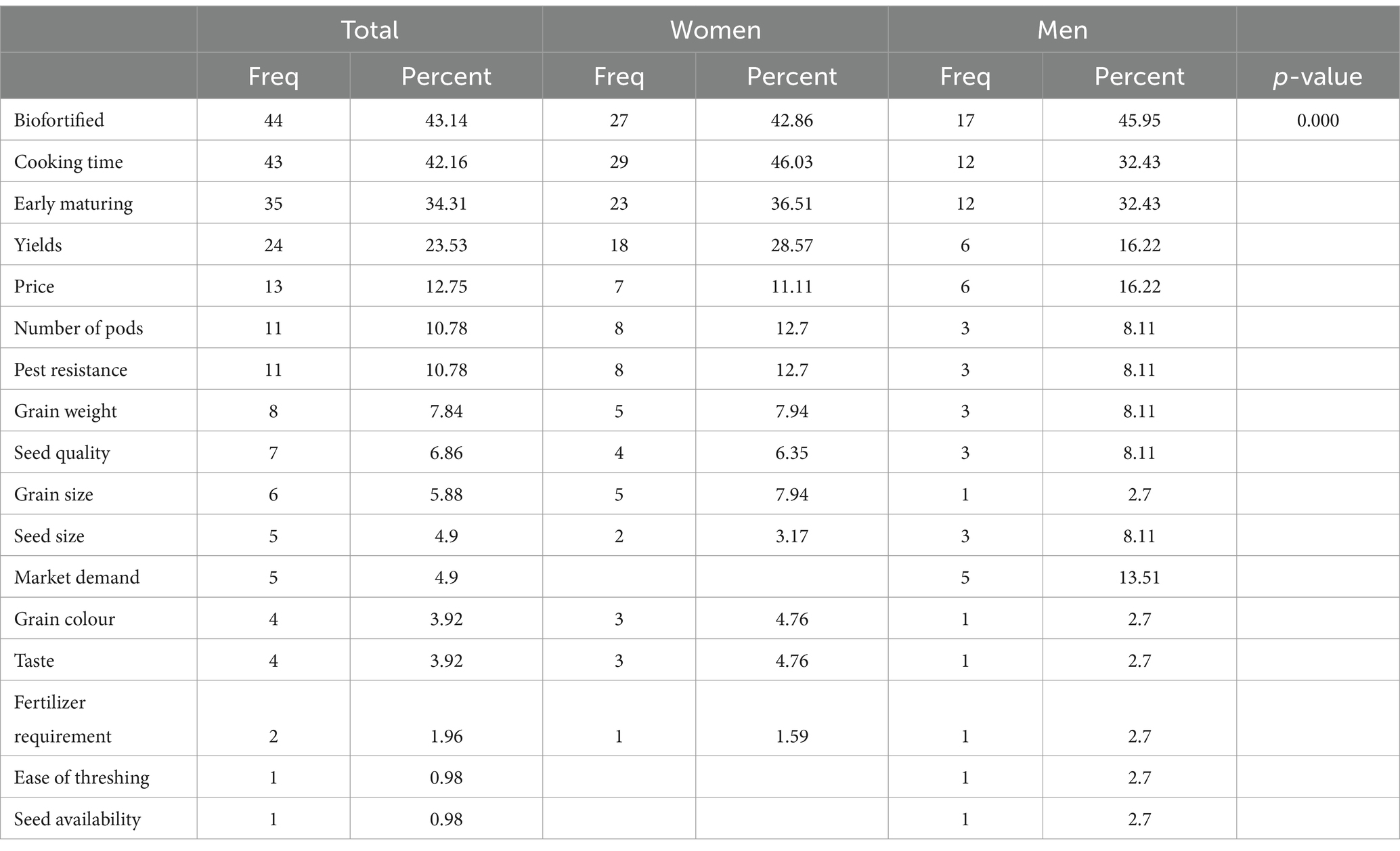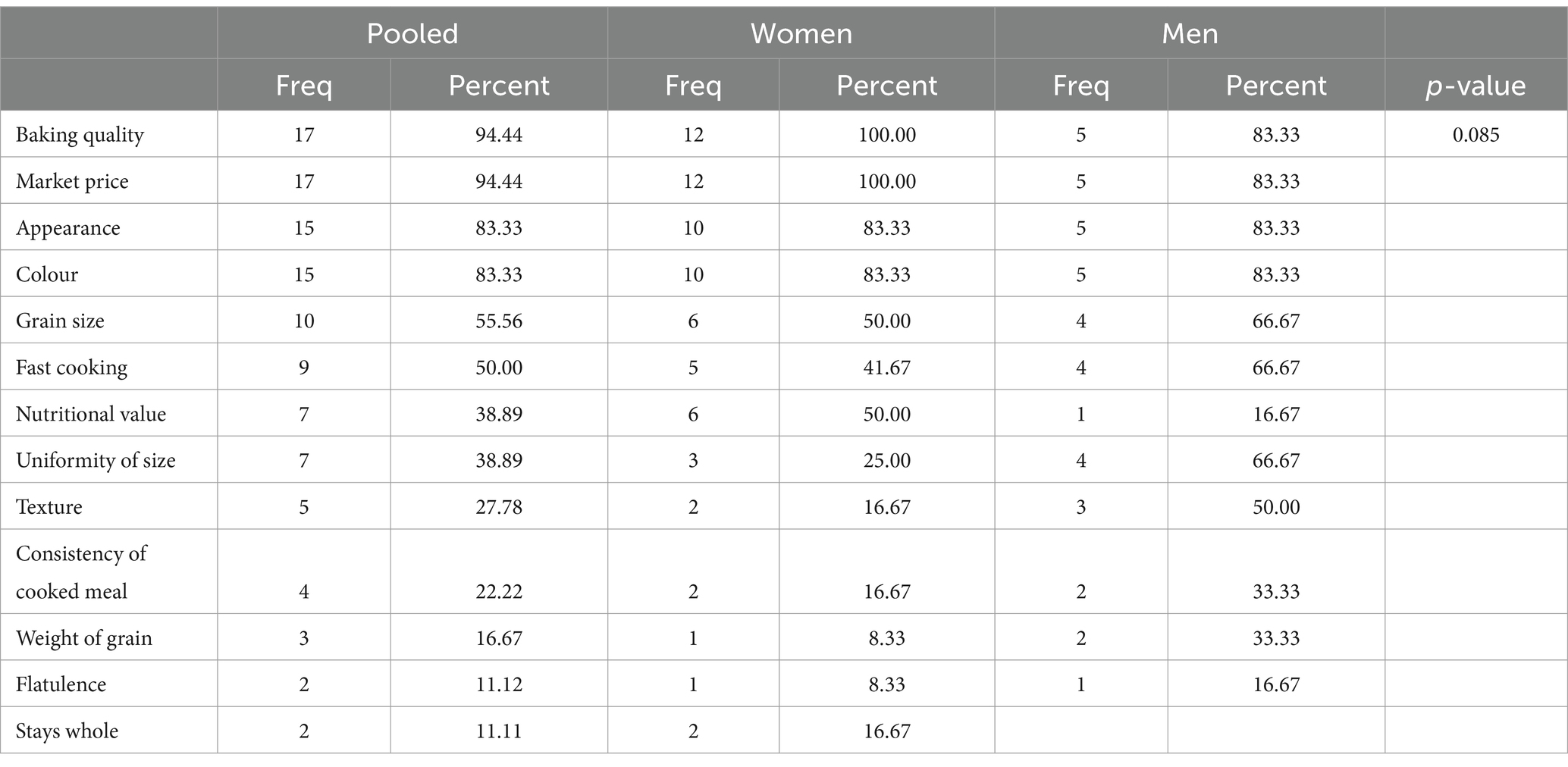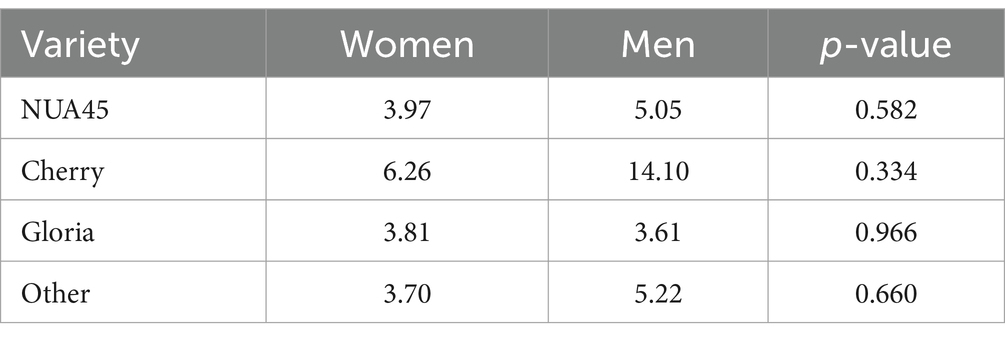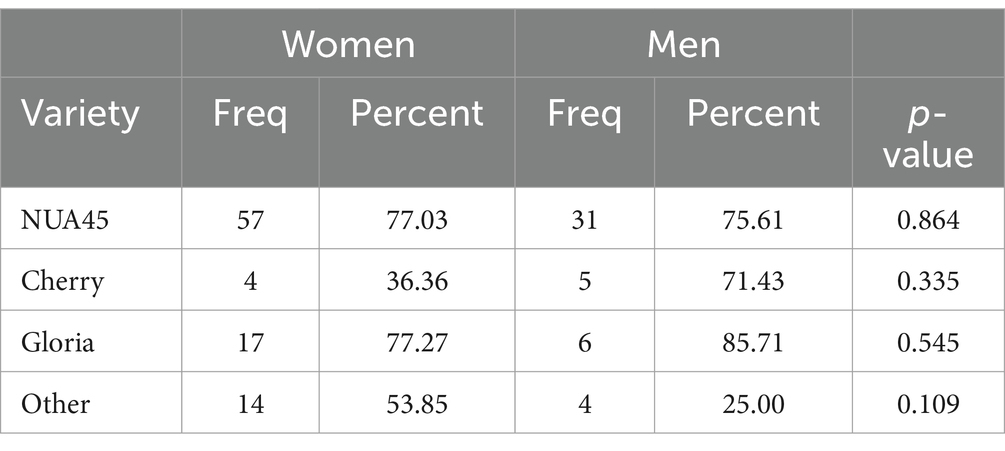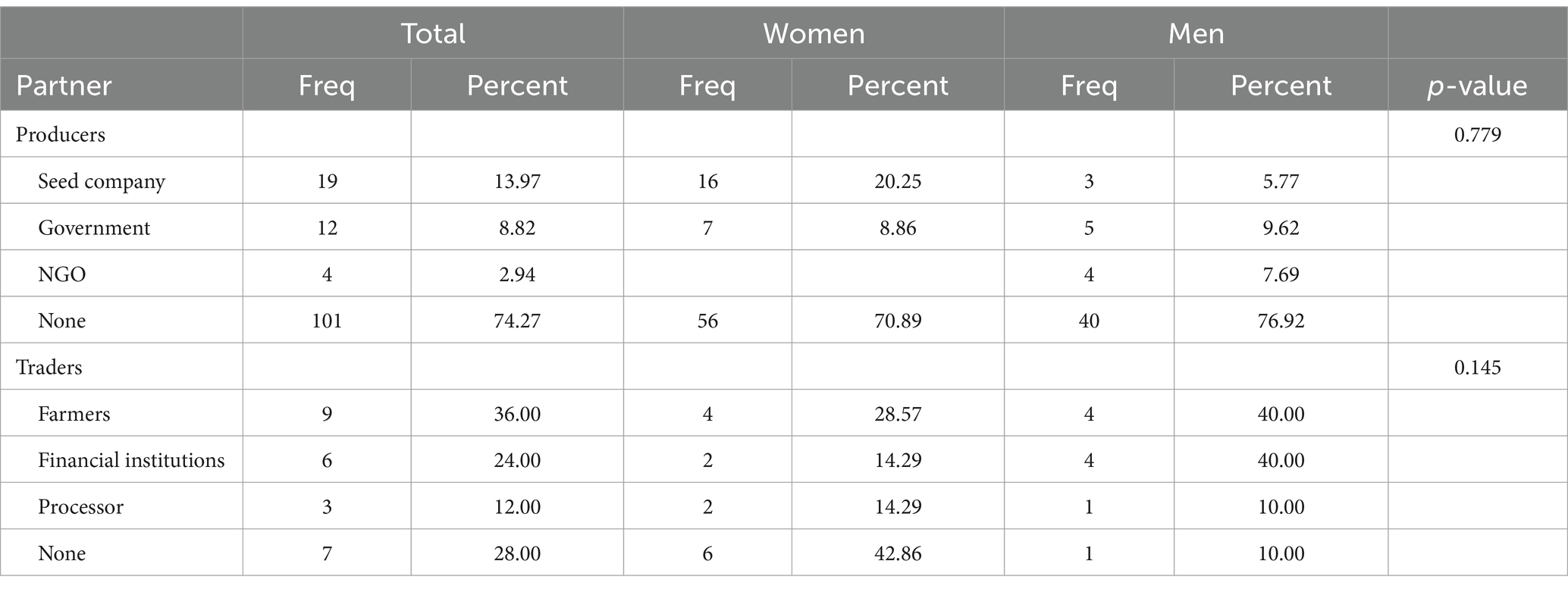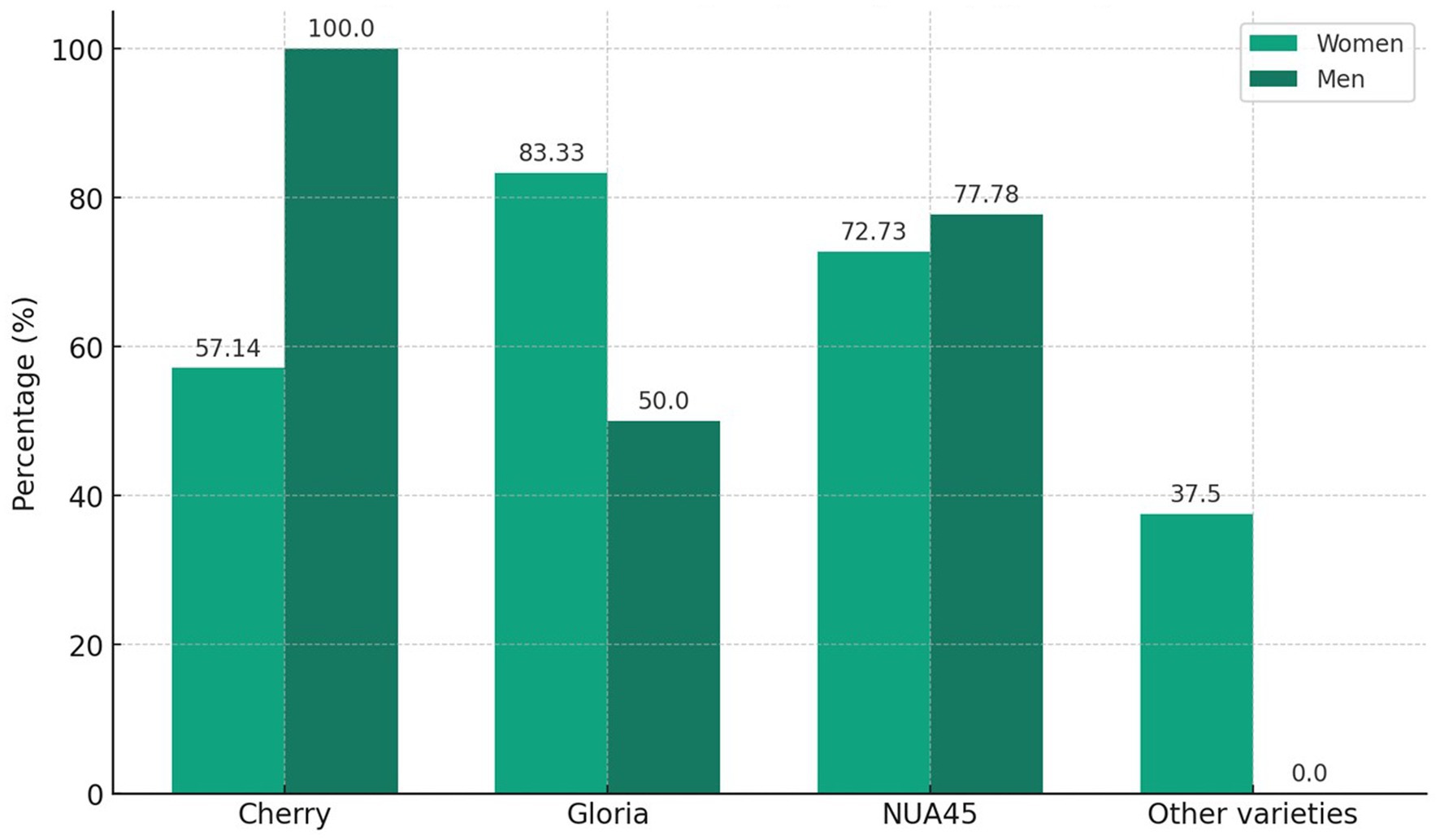Breaking ground: transformative partnerships for inclusive bean breeding in Zimbabwe
- 1International Centre for Tropical Agriculture, Nairobi, Kenya
- 2Agricultural Research, Innovation and Development, Department of Crop Research, Harare, Zimbabwe
- 3Kenya Agricultural and Livestock Research Organization, Nairobi, Kenya
Common bean is often considered a woman’s crop because they play important roles from production to marketing. However, breeding programs often focus on farmers without adequate attention to the interconnectedness between gender and other socioeconomic variables and how they influence varietal and trait preferences of other value chain actors. This study analyzed gendered differences in bean production and trade, implications of socioeconomic conditions on bean production and marketing, and the role of partnerships in closing gender gaps in the bean value chain in Zimbabwe. The results obtained from the analysis of survey data collected from 131 farmers and 18 trades revealed beans as a dual-purpose crop for male and female farmers and traders. Varietal and trait preferences were the same for both male and female farmers and traders but were prioritized differently. While female farmers prioritized cooking time, men farmers prioritized biofortification and market traits. Whereas male traders equally preferred price, color, and appearance, female traders prioritized price over color and appearance. Poverty and marital statuses of respondents influenced the number of varieties preferred by male and female farmers. We found that the effectiveness of partnerships in closing gender gaps in marketing is variety specific. While having partners closed the gender gaps in the marketing of the NUA45 variety, such partnerships did not have the same effect on closing gender gaps in the marketing of Cherry, Gloria, and other varieties. The results show that considering socioeconomic characteristics of actors and partnerships can reduce gender disparities in the bean value chain. Therefore, breeding programs should recognize the interconnectedness between socioeconomic variables and gender when developing breeding products.
1 Introduction
Common bean (Phaseolus vulgaris L.) is considered a multipurpose crop due to its role in food security, nutrition, income, and sustainable production systems. The major bean producers in Eastern and Southern Africa are primarily smallholder farmers who often utilize family labor because of the small landholding and face several challenges, including low access to improved bean varieties, unreliable markets, price fluctuations, limited access to capital, input resources, and low grain yield. These constraints are not equally perceived by men and women because of socioeconomic disparities, despite the crop being considered a women crop (Ingutia and Sumelius, 2022).
Similarly in other countries in sub-Saharan Africa, common bean in Zimbabwe is also considered a women crop. Mutari et al. (2021a,b) estimate that 60% of women participate in the bean value chain across the country. However, their participation is mostly limited to the production and post-harvest and processing stages, whereas men dominate the lucrative nodes of the value chain, including processing and exports (Nchanji et al., 2022a,b). Low level of women participation in the lucrative stages of the value chain is a major concern, especially in the post-2000 period, when Zimbabwe is experiencing decline in agricultural productivity. Women under representation in the bean value chain is further compounded by declining trend in bean production since 2004 due to climate change, pests and diseases, low use of improved technologies, and economic instability and land reforms (Katungi et al., 2017; Foti et al., 2020; Mutari et al., 2021a,b). For instance, limited availability of improved local breed varieties compels farmers to grow low-yielding, disease susceptible, and stress intolerant varieties, resulting in low yields and low-quality grain (Mutari et al., 2021a,b). These constraints disproportionately affect women who play a critical role in common bean production and food environment (Okello, 2018).
There has been an increasing focus on Zimbabwean common bean value chain in response to the constraints experienced by farmers in the last decade. Plant breeding and scaling programs through private and public sector collaborations have increasingly focused on contributing to nutrition security and equality through biofortification, gender-responsive, and demand-led bean breeding and scaling programs. These interventions have resulted in the introduction of improved biofortified bean varieties that promise to challenge gender and nutritional disparities (Zozo et al., 2021). Examples of biofortified and market-demanded varieties released in the past decade are NUA 45, Cherry, Gloria, and Sweet Violet in 2016 (Akesson et al., 2016).
Increased adoption and bean productivity were expected to increase grain availability and reduce imported grain (Mutari et al., 2021a,b). However, the adoption of newly released bean varieties is not a straightforward process as it involves the interaction between several factors (e.g., gender, access to resources, socioeconomic context, and partnerships) which need to be considered during cultivar development (Foti et al., 2020). Breeding programs should recognize and consider sources of gender differences in varietal and trait preferences and determine how to integrate them to minimize trade-off of technology adoption. This is because male and female farmers might have identical or different trait preferences which may influence gender differences in technology adoption (Ashby and Polar, 2021). Even when preferences are identical, prioritization may differ by gender or change according to ecological, social, and economic or market circumstances (Mutari et al., 2021a,b; Phiri et al., 2022). Thus, the understanding men and women’s trait preferences and role of socioeconomic and institutional factors that shape preferences is crucial in developing bean cultivars that will bridge gender gaps and increase bean productivity in Zimbabwe (Anja et al., 2017; Mutari et al., 2021a,b).
Partnerships in the broader value chain—bean breeding, production, and marketing—ensure that product profiles respond to market demand. Therefore, partnerships are vital to support inclusive development (Aseete et al., 2023). These partnerships include both collaborations between breeders and value chain actors from variety development to scaling of new bean cultivars. However, plant breeding programs in Zimbabwe tend to emphasize farmers’ trait preferences without adequately focusing on downstream actors, such as traders and processors. Consequently, breeding programs do not adequately ensure that bean products benefit other factors in the value chain beyond the farming community (Ragot et al., 2018). Therefore, studying gendered trait preferences and the role of partnerships in the broader bean value chain—encompassing breeding, production, and marketing—is crucial for several reasons, including ensuring demand-led breeding, promoting inclusive development, addressing farmers’ and other downstream factors’ needs, and facilitating scaling of innovations.
This study acknowledges interconnectedness between gender and other socioeconomic variables, how they influence varietal and trait preferences of farmers and traders, and how partnerships in the bean value chain can close existing gender gaps. The novelty study is the focus on how gender and socioeconomic variables can form the basis for creating equitable partnerships in bean breeding, production, and trade for inclusive benefits. It contributes to understanding how gender gap in bean value chain could be minimized through partnerships that are built on user and technographic viewpoints, thereby integrating gender considerations into breeding programs. Thus, the study answered three research questions: (1) What are the gendered differences and choice in bean production and trade?, (2) What are implications for and influence on bean production and marketing of male and female farmers?, and (3) Are partnerships in bean production bridging gender gaps in bean production and marketing?
2 Theoretical framework
Innovations in agriculture often perceived to be only technologies or practices that farmers adopt to increase the performance of farm enterprises or address production constraints. However, innovations in agriculture are not merely physical objects but encompass the entire process of technology adoption. Technological change is a complex, multi-component process that involves not just biophysical resources but also invisible innovations that could be interactions, agency, and capabilities of multiple actors involved in the development and dissemination of technologies (Glover et al., 2019). Thus, we use the concept of inclusive innovation as a theoretical basis to highlight gender-sensitive breeding in Zimbabwe.
Innovation is a process of change where new knowledge, skills, social arrangements, or solutions are applied to address diverse challenges in society (Stenberg, 2017). It offers solutions to social issues, such as income inequality and food insecurity. Inclusivity is defined as a system that does not “leave behind” any factor based on gender, ethnic origin, disability, or social status (Phiri et al., 2022). Inclusive innovation is one type of innovation that meets people’s needs by involving everyone without discrimination. As a result, inclusive innovation mitigates social constraints such as income inequality and food and nutritional insecurity (Rip and Rip, 2018).
Inclusive innovation aims to achieve socially desirable outcomes such as equality alongside its economic objectives. The concept advocates supporting innovations that address societal challenges and needs, especially of excluded groups (Opola et al., 2021). Inclusivity also focuses on increasing the participation of socially excluded, disadvantaged, and under-represented groups in innovation pipelines. In addition, inclusive innovation aims to contribute to the promotion of technological progress in low-productivity sectors, ensuring that the benefits of innovation are equally distributed. Opola et al. (2021) identified three narratives that define an inclusive innovation concept: bottom of the pyramid, grassroots, and political economy. We draw upon these distinct narratives to provide a comprehensive framework for investigating interconnectedness between gender and other socioeconomic variables in influencing varietal and trait preferences in the bean value chain in Zimbabwe.
The bottom of the pyramid narrative emphasizes the untapped potential of low-income markets, such as smallholder male and female farmers. It argues that innovations can be scaled to benefit marginalized communities when their unique needs, priorities, challenges, and opportunities are understood (Opola et al., 2021). In the context of bean breeding and the entire value chain, the bottom of the pyramid narrative helps in understanding how new varieties can be made accessible and beneficial to smallholder farmers, traders, and other downstream actors. The grassroot innovation narrative focuses on the agency of local communities in technological change. According to Glover et al. (2019), it aligns with the concept of ‘affordances,’ highlighting the resources and opportunities that local environments offer for functional interaction with new bean varieties. In the context of this study, functional interaction or opportunities could be contract farming and partnerships at different nodes of the value chain. The political economy narrative provides a critical lens on the structural factors (e.g., socioeconomic characteristics) that systematically influence opportunities and behavioral factors in the bean value chain. According to Glover et al. (2019), this narrative resonates with discussion on “dispositions” and “responses,” emphasizing the evolving behavior of bean value chain factors as they engage with new technologies.
3 Materials and methods
3.1 Study area
Zimbabwe consists of five major agro-ecological zones that are typically linked to the country’s topography. Agro-ecological regions 1 and 2 are suitable for various agricultural activities including maize, bean, tobacco, and horticultural crops. Agro-ecological region 3 is characterized by semi-intensive farming; 39% of the farming systems are smallholder-based, and receive 650–800 mm of rainfall annually, while agro-ecological regions 4 and 5 experience lower rainfall (maximum 600 mm annually) and higher temperatures. The study was conducted in three provinces of Zimbabwe: Manicaland, Masvingo, and Midlands (Figure 1). Manicaland is part of natural regions 1 and 2. Masvingo is in agro-ecological zones 4 and 5, while Midlands is located in zone 4. Manicaland has diverse farming systems due to relatively good rainfall and fertile soils. Compared with Manicaland and Midland, Masvingo is known for livestock farming, particularly cattle and goats. Farmers in Masvingo use improved crop varieties and irrigation to sustain agricultural production as an adaptation to lower rainfall and higher temperatures. Midlands is known for its mixed farming system, including both crop production under drip irrigation and livestock rearing, due to minimal and uncertain rainfall.
The primary constraints to future food security across these provinces are the reliability and volume of seasonal rainfall, particularly in the semi-arid regions. Adoption of climate-smart improved technologies is emphasized as a crucial strategy to mitigating the effects of climate change. Crop suitability assessments in the three provinces indicated that legume production can help the realization of climate action agenda and contribute to food security. Various organizations, ranging from governmental bodies to NGOs and private entities, are involved in research, community development, and the dissemination of agricultural technologies, contributing to climate change adaptation and food security. For instance, collaborations between national and international research organizations through regional alliances have spearheaded the development of biofortified bean varieties that have been disseminated by the extension system in Midlands, Masvingo, and Manicaland.
3.2 Sampling design
Using multi-stage sampling procedure, three provinces and four districts were purposively selected because they were intervention areas of improved common bean variety dissemination programs of PABRA and the Department of Research and Specialist Services of Zimbabwe. Nyanga, Mutasa, and Chimanimani districts in Manicaland province, Shurugwi and Kwekwe districts in Midlands province, and Masvingo district in Masvingo province were selected. This was followed by a purposive selection of farmer groups. It involved the use of extension officers who provided lists of farmers in different farmer groups. The sampling frame comprised 655 farmers, the total number of farmers that were consolidated from the lists provided by extension officer. The sampling involved systematic random sampling after every 5th farmer. Applying a sample size calculation for finite populations, 243 farmers were included. However, due to logistical challenges amidst COVID-19 pandemic, the sampling procedure consisted of the sample size of 131 farmers (52 men and 79 women). Traders were also purposive selected, depending on their availability, which resulted in a sample size of 18 farmers (6 men and 12 women). Initially, the study was designed to conduct a comprehensive survey, targeting grain traders and processors in the three provinces. The unforeseen challenges posed by COVID-19 restrictions, including market closures, and prevented face-to-face administration with traders as intended. The data collection tool was shared with traders electronically. On the other hand, COVID-19 restrictions prevented sampling of processors as earlier mentioned in the study.
3.3 Data collection and analysis
The study used semi-structured questionnaires to collect data from sampled male and female farmers and traders. The sampling unit was male and female farmers involved in bean production. Farmers were selected based on their specific roles and involvement in bean production, irrespective of their position in households. The farmer questionnaire collected household socioeconomic characteristics, farm characteristics, bean production, varietal and trait preferences, and bean production partnership or arrangements. The trader questionnaire was programmed for digital data collection due to COVID-19 containment measures that restricted movement. Therefore, the free online survey tool, https://freeonlinesurveys.com/s/EsOG2nln#/0, was used to collect data from 6 male and 12 female traders. Trader survey involved telephone interviews by trained extension officers who recorded the responses in the free online survey tool. The data collected from traders included bean products, varietal and trait preference for grains, partnership, and bean business characteristics. The collected data reflected the diverse experiences and needs of farmers and traders, irrespective of their gender, social status, or role in the bean value chain, which aligns with the inclusive innovation framework.
The collected data were analyzed using Stata version 18. The analysis involved measures of central tendency, mean and standard deviations, proportions, frequencies, and percentages. Test of significance—chi-square test of independence, Fisher’s exact test, and sample t-test—was used to test for systematic differences between responses provided by farmers. Tests for significance differences were not performed on trader responses due to small sample sizes. Cross-tabulation of results allowed comparison of men and women responses and contributed to the understanding of how gendered differences were associated with varietal and trait preferences. This ensured that analytical approach aligned with the theoretical emphasis on gender-sensitive breeding practices in Zimbabwe.
4 Results
4.1 Sociodemographic characteristics of producers and traders
As shown in Table 1, the analysis shows the results of sociodemographic and farm characteristics of producers who participated in the study. In total, 60% of the respondents were women and 40% were men, suggesting the dominant role of women in bean production in Zimbabwe. The average age of the respondent was 49 years for women and 48 years for men, and this shows that most common bean farmers are adult with the involvement of a few youths. The majority of the respondents were married (68% women and 86% men), 27% women and 4% men were widowed, and 5% women and 10% men were single. Most of the respondents achieved a secondary education or higher (60% women and 77% men), 35% women and 24% men had primary education, and 5% women had no formal education. Literacy levels are important in acquiring agricultural knowledge and information for both men and women; thus, the results indicate that there is a high possibility for the respondents to acquire knowledge on improved bean varieties.
In total, 47% women and 40% men had household income of less than 40,000 Zimbabwean dollars, 33% had an income ranging between 40,000 and 100,0000 Zimbabwean dollars, and only 3% had an income above 250,000 Zimbabwean dollars. The landholding for men and women was 1.67 acres and 0.90 acres, respectively. Approximately 23% of men and 29% of women reported that they received support from partners, such as seed companies, government, and NGOs.
Table 2 shows sociodemographic and business characteristics of traders. Overall, 67% of traders were women and 33% were men. Women traders had higher educational attainment (secondary or higher), and higher percentage of them performed as agro dealers than men. There was an equal number of male and female bean aggregators, while more men (67%) than women (42%) performed as retailers. Nonetheless, more men than women operated formal and commercial enterprises, suggesting differences in nature of businesses operated by male and female traders. The gender differences in bean trade are also revealed by higher trading capacity (2.5 MT) per month of men-owned business which is twice the monthly bean volumes traded by women. The operational capacity of male trader is also higher than female traders as shown by higher number of male and female employees hired by male traders. Moreover, bean trading is more profitable for men ($6,850 per annum) than women ($3,843 per annum), as shown in Table 2. The analysis of type of bean product revealed that the percentage of women who traded bean grain (92%) was higher than the percentage of men (67%). While one-third of men traded canned beans, only 8% of women reported trading canned beans.
4.2 Objectives of bean production and varietal preferences
The results in Table 3 indicate that NUA45 was the most produced and traded bean variety as reported by 57 and 31% of farmers and traders. Gloria and Cherry were the second and third most produced and traded bean varieties by both men and women. Furthermore, most respondents engaged in bean production and trade with an objective of achieving both food and income, regardless of gender and varietal preferences.
Respondents were then asked to state traits of the most preferred bean variety—NUA45 (Table 4). The p-value of 0.000 indicates that there are statistically significant differences in the overall preferences between women and men. Biofortification trait was highly preferred by both women (43%) and men (46%), suggesting that this trait is significantly important for both genders. Early maturing was similarly important for both women (37%) and men (32%). More women (46%) preferred NUA45 because of cooking time compared with 32.43% men.
Trader trait preferences for bean varieties are presented in Table 5. The results also revealed that men and women preferred same traits albeit with differences in prioritization. Quality and market price were preferred by 100% of the female traders compared with 83% of male traders. The appearance was also highly important for both genders (83%). However, some gender disparities in the consistency of cooked meal and fast cooking were observed. More men (33.33% for consistency and 66.67% for fast cooking) prioritize these traits compared with women (16.67 and 41.67%, respectively).
4.3 Implications of socioeconomic conditions on varietal preferences
The results presented in Table 6 indicate that variety preferences for men and women differed by poverty status. NUA45 appears to be the most preferred bean variety, which is grown by both poor (women 60%, men 59%) and non-poor (women 68%, men 73%) farmers. Among non-poor farmers, men showed a preference for Cherry and other varieties, while women primarily opted for Gloria and Cherry. Interestingly, poor farmers, irrespective of their gender, exhibited greater diversity in their planting choices, growing up to five different varieties compared with three varieties planted by non-poor farmers.
Table 7 presents a detailed disaggregation of bean varieties preferred by farmers by marital status and gender. Married farmers of both genders (women: 68%, men: 83%) compared with those who are not married (women: 32%, men: 18%) preferred NUA45. Similarly, Cherry was popular among married individuals (women: 72.73%, men: 83%) than those not married (women: 27%, men: 17%). All married men (100%) and 73% of married women preferred Gloria. Other varieties (Ngonda, Sweet Violet, Willian) were predominantly grown by married individuals (women: 80%, men: 94%) compared with those who were unmarried (women: 20%, men: 6%). While there are observable trends in the data, statistical tests for differences in male and female farmers’ preferred bean varieties by marital status indicated no significant differences.
As shown in Table 8, the results of land allocation to bean varieties indicate that men allocated larger land areas to NUA45, Cherry, and other bean varieties than women albeit not significantly different. In contrast, women allocated larger land area to Gloria than men. As shown in Table 8, the absence of significant differences in land allocation by men and women reflects similar findings of no statistically significant variation in bean variety preferences by marital status and gender, as shown in Table 7.
4.4 Implications of socioeconomic conditions on bean marketing
Table 9 presents the bean varieties that are preferred for marketing by farmers, which is disaggregated by gender. Both women (77.03%) and men (75.61%) showed almost equal preference for marketing NUA45. The proportion of women who preferred other bean varieties (Sweet Violet, William, and Ngoda) with an objective of selling was more than double that of men, but this difference was not statistically significant (p = 0.109). In addition, a higher percentage of men preferred Cherry and Gloria for marketing compared with women.
As shown in Table 10, variety preferred by farmers for marketing was disaggregated by poverty status and gender. Non-poor women preferred for marketing of all four varieties, while non-poor men only preferred to sell NUA45. Poor farmers (earning less than 100,000 Zimbabwean dollars ($265.7) per months), regardless of gender, preferred to sell all bean varieties in the market. A higher proportion of poor women preferred selling other varieties than poor men. In contrast, higher percentages of poor men preferred selling NUA45, Cherry, and Gloria than poor women. The Zimbabwean government policy on biofortification of industrial products has led to an increase in utilization of NUA45 in the industries. As shown in Table 11, most of the unmarried women prefer selling NUA45, Gloria, and other varieties than their men counterparts. In contrast, higher percentages of married men prefer NUA45, cherry, and Gloria than unmarried women farmers. More married women prefer other varieties than married men. However, comparison between poverty (Table 10) and marital status (Table 11) is generally not statistically significant, indicating that differences in farmers’ preferences for marketing of bean varieties do not vary based on marital status or gender.
4.5 Partnerships and closing gender gaps
Table 12 presents the percentages of farmers and traders with bean production and marketing partners, respectively, disaggregated by gender. In total, 26% of the sampled farmers engaged in partnerships for bean production. When analyzed by gender, 29% of female farmers had bean production partners compared with 23.08% of male farmers. Although women were slightly more likely than men to engage in partnerships for bean production, the absence of a statistically significant difference (p = 0.779) between the percentages of female and male farmers with bean production partners suggest that gender is not a determining factor in men and women engagements with service providers in the bean value chain. Even so, men had three production partners (seed company, government, and NGO) while women had two production partners (seed company and government). Table 12 also shows that 72% of traders had partners in bean marketing, albeit with no significant difference by gender [women (57%), men (90%)]. Approximately 43% of female traders had no partners compared with only 10% of male traders. Higher percentages of male traders had farmers (40%) and financial institutions (40%) as partners in bean marketing compared with female traders. In contrast, more female traders (14%) than male traders (10%) had processors as partners. For the NUA45 variety, partnerships appear to almost equalize market participation between women and men (Figure 2). However, for other bean varieties such as Cherry and Gloria, partnerships did not yield similar positive outcomes in closing gender disparities in marketing.
5 Discussion
Common bean is often considered a women’s crop in sub-Saharan Africa because women are typically more involved in production for subsistence purposes. However, the results presented in this study depict common bean as a dual-purpose crop as shown by higher percentage of male and female producers and traders who prefer the varieties for both food and income, according to Nakazi et al. (2017). The results suggest that traders are only trading locally supplied grain because what they prefer exactly matches what is produced. Alternatively, farmer’s preferences are driven by what is demanded in the market. A higher percentage of male producers prefers NUA45 for income/sale than women, suggesting that men are more market-driven in their preference for NUA45. In contrast, female traders prefer trading NUA45 and Cherry for income than male traders, who prefer Gloria for income generation than female traders.
The results show that men and women prefer the same traits, but prioritization of the traits differs. Women preferences and prioritization of cooking time over other traits could be because it saves time for other activities or fuel/wood which women are mostly responsible for collecting (Nchanji et al., 2021). Higher preferences for market traits (market demand and price) among men than women could be because men are responsible for most household purchases (Siri et al., 2020), explaining why a higher percentage of men responded that they prefer NUA 45 for sale/income. Women play important roles in post-harvest activities, such as threshing, winnowing, and sorting (Nakazi et al., 2017). Then, the expectation was that female farmers would prefer labor and time-saving innovations. However, this is not the case in our study as none of female respondents mentioned post-harvest traits as preferred traits. Instead, a few male producers mentioned ease of threshing as one of the preferred traits. This result suggests possible trade-off with women not minding technologies that cause drudgery as long as they reduce cooking time, contribute to household food and nutrition security (biofortification, earliness, high-yielding, and resistant to biotic stress).
Both male and female traders mostly preferred the same traits in the same order. The first four traits of most preferred bean varieties by traders are market price, color, appearance, and grain size. Traders always purchase what the consumers want. For most of the local food crops like beans, traits such grain size stand out among the most important for consumers purchase decisions (Kuntashula et al., 2012) while for traders the bigger the grain size the less quantity placed in a bag and more money in the pocket.
The finding that common bean serves as dual purpose crop highlights the need for breeding programs in Zimbabwe, to focus on developing cultivars that cater for both subsistence and market needs of bean producers. Specifically, breeding programs should target traits that enhance productivity and marketability and those that directly impact household food security and nutritional quality. Example of productivity and marketability traits that could be considered are yield, pest and disease resistance, and grain size and appearance. Biofortification and short cooking time could be considered as critical traits for ensuring food security and nutritional quality. Second, men prioritization of market-oriented traits and women preferences for time-saving traits underscore the need for a gender-responsive breeding approach. Women trait preferences provide an opportunity for common bean breeders to focus on developing biofortified and high-yielding bean varieties that reduce cooking time and drudgery. Lastly, the low prioritization of post-harvest traits by women, despite their significant contribution to bean production, underlines possible trade-off, confronting women when selecting varieties to produce (Ashby and Polar, 2021). This provides an opportunity for innovations (e.g., bean threshers) that ease post-harvest activities without compromising women’s preferred traits.
Poor farmers, regardless of gender, preferred many varieties than non-poor farmers. NUA45 was preferred by both poor and non-poor farmers due to its availability and awareness creation as a nutritional panacea to malnutrition in the country. Non-poor farmers are mostly market-oriented as they prefer varieties that fetch profits possibly because of higher food security status compared with poor households. These findings align with the concept that crop variety selection is responsive to changes in income, with income variations leading to diverse choices (Nakazi et al., 2017). Non-poor farmers have a better access to resources, knowledge, and access to mechanization equipment. They may also have higher knowledge about the latest farming techniques than poor farmers. These factors may incentivize them to engage in markets compared with poor farmers (Nchanji et al., 2021). Furthermore, the result showed that married men are likely to have a large portfolio (diverse) of preferred bean varieties than married women. This could be linked to possible influence of gender norms or differences in access to information or knowledge about availability of bean varieties, leading to differing preferences for bean varieties between men and women (Nchanji et al., 2021).
There were also gender differences in land allocation to bean production. The results could suggest possible differences in constraints to men and women access to resources or the importance or prioritization traits. Men’s preferences for NUA45 and Cherry, attributed to their marketing, along with gender disparities in access to land, may explain why the allocated larger sizes of land allocated to bean production than women. In contrast, female farmers allocated more land to Gloria than NUA45 and Cherry possibly because of their preference for the color trait as earlier reported by Nchanji et al. (2021). Furthermore, the results show that marital status had an impact on market participation of male and female farmers. Unmarried and married women and men sold all the varieties, while unmarried men only planted varieties, they considered profitable varieties—NUA45 and Cherry.
Three implications can be drawn from the findings on relationship between socioeconomic variables and preferences for bean varieties. First, higher preference of NUA45 by both poor and non-poor is a further testament for developing and promoting nutritional and market-oriented varieties. This would address the food security and nutritional needs of poorer households and cater to the market-oriented strategies of non-poor farmers. Additionally, bean breeding programs in Zimbabwe should incorporate socioeconomic diversity in breeding strategies to respond for varying levels of access to resources, knowledge, and market engagement between poor and non-poor farmers and women and men. For instance, design of less-input intensive, high productivity, and market appealing bean varieties would cater for needs and targets of both poor and non-poor farmers. Breeding programs should also consider gender and intersectional elements such as poverty and marital status when designing bean varieties to ensure that the breeding process prioritizes traits that are specifically valued by women and men while minimizing trade-off.
Furthermore, the study found that male producers had three partners (seed company, government, and NGOs) while women producers had two partners (seed company and government) that supported bean production. Seed company is the most frequently mentioned partner for women and government is the most frequently mentioned partner for men producers. The type of relations/partnership is possibly limited to already developed seed and dissemination of information about already developed bean technologies via government and NGO extension. Unlike producers, higher percentages of traders have trading partners. Gender disparities were clear with higher percentage of male traders, indicating financial institutions as partners compared with women. This aligns with the bottom of the pyramid narrative that argues that some factors exclude resource-poor factors in value chains (Opola et al., 2021). Women had lower operational capacity and profitability, therefore their bean trading enterprise offered weak business case for financial lenders. It is also consistent with political economy argument for inclusive innovation where male traders can easily access/own collateral-to-secure financial assistance than women (Saha, 2016). As supported by the results presented in Table 12, farmers’ relationships with traders were informal and typically confined to farmgate transactions, which was characterized by unstructured terms of engagement.
The finding about gender differences in engagement in partners for both farmers and trader suggests the need for enhancing inclusivity in support networks created by bean breeding programs to ensure equal access to a diverse array of support networks, especially among women. In addition, targeted financial inclusion programs, involving training in business management and bookkeeping, are needed to facilitate access to credit by female traders. The possibility of unstructured terms of engagement between farmers and traders would require strengthening of formal relationships and equitable market access.
Finally, the results indicated that partnerships had a differential impact on closing gender gaps depending on the type of bean varieties. Having partners enable men and women to equally participate in selling NUA45 but did not close gender gaps in marketing of Cherry and Gloria. Although the findings highlight the need for partnerships to support women participation contract farming and markets, there are embedded differences in how models integrate gender inclusivity. Thus, partnerships in bean production are critical for working toward the political economy narrative of inclusive innovation. Additionally, interventions tailored to the unique challenges and opportunities associated with each variety may be necessary to achieve gender equity in market participation.
6 Conclusion
This study confirms that male and female farmers are traders who often have different or similar traits which may be prioritized differently. Partnerships play a significant role in almost closing these gender gaps and can be beneficial for more intersectional groups such poor men and women and food-insecure and food-secure individuals. Some trait preferences often considered exclusively for women are often not mentioned if women consider it as their role especially traits related to threshing and winnowing which were highlighted by men not women farmers. Even though women mentioned post-harvest traits, they were prioritized last as cooking time and biofortification were prioritized higher, suggesting trade-off.
NUA45 was the most preferred variety by producers and traders due to extensive awareness creation about micronutrient trait. It was one of the varieties promoted to support the fortification policy. In addition, NUA45 was preferred by poor and rich farmers because of short cooking time, biofortification (iron and zinc), early maturing, high yield, and a good price. Thus, the fortification policy created a space for inclusive technology that considered the needs of all value chain actors with diverse social categories. Trader traits and producer traits were similar, showing that farmers are aware of what the market demands are striving to meet their needs.
Gender disparities are evident depending on the partnership engaged in bean production and marketing. While it may appear in the results that men producers have double the number of production partners as women, the actual difference is only one partner. Male traders are more likely to find financial assistance than women. This indicates an unequal access to resources and institutional support, suggesting a need for partnerships that specifically support women to achieve inclusive bean production and marketing. It is recommended that partnerships are formed to support women to participate in bean partnerships in bean production and marketing for the achievement of an inclusive bean value chain.
The primary limitation of our study is its reliance on quantitative data, which prevented a deeper understanding of the social, cultural, and economic factors influencing varietal and trait preferences in the bean value chain. Another limitation is the small sample size of traders, which restricts the generalizability of our findings and limits the statistical power for more complex analyses. Regression analysis would have provided more robust inferences in association between institutions (partnerships), gender and poverty with farmers, and traders’ preferences for bean varieties. Therefore, future research could benefit from using a large sample size of traders and employing a mixed-methods approach to provide deeper insights into the complexities of bean value chain dynamics, gender roles, and the effectiveness of various partnership models.
Data availability statement
The raw data supporting the conclusions of this article will be made available by the authors, without undue reservation.
Ethics statement
The studies involving humans were approved by Department of Research and Specialist Services, Zimbabwe. The studies were conducted in accordance with the local legislation and institutional requirements. The participants provided their written informed consent to participate in this study.
Author contributions
EN contributed to the study by conceptualizing, acquiring funding, investigating, developing methodology, drafting the original manuscript, and reviewing and editing. NC, ST, and FG contributed to the study by conceptualizing, developing methodology, supervising data collection, and reviewing and editing the manuscript. JM and CL contributed to the study by developing methodology, analyzing data, writing the original draft, and reviewing and editing the final draft manuscript. All authors contributed to the article and approved the submitted version.
Funding
This work was supported by the CGIAR Excellence and Breeding Platform (EiB), the CGIAR GENDER Platform, with funding provided by the Bill and Melinda Gates Foundation (BMGF). It built on existing work funded by the Swiss Agency for Development and Cooperation and TAAT through Pan Africa Bean Research Alliance and partners. The publishing of this paper is funded by the Bill and Melinda Gates Foundation grant INV-009649/OPP1198373.
Acknowledgments
Thanks to CGIAR Excellence and Breeding Platform (EiB) and the CGIAR Gender Platform for technical support to the project. We are grateful to Bill and Melinda Gates Foundation (BMGF) for funding the project. Thanks to Swiss Agency for Development and Cooperation and TAAT through Pan Africa Bean Research Alliance and partners for providing a framework on which the project was anchored. Many thanks go to farmers and other stakeholders who provided information without which this study would not have been successful.
Conflict of interest
The authors declare that the research was conducted in the absence of any commercial or financial relationships that could be construed as a potential conflict of interest.
Publisher’s note
All claims expressed in this article are solely those of the authors and do not necessarily represent those of their affiliated organizations, or those of the publisher, the editors and the reviewers. Any product that may be evaluated in this article, or claim that may be made by its manufacturer, is not guaranteed or endorsed by the publisher.
References
Akesson, U., Wingqvist, G. Ö., Ek, G., and César, E. (2016). Environmental and climate change policy brief Zimbabwe. Gothernburg: Sida's Helpdesk for Environment and Climate Change. Available at: https://sidaenvironmenthelpdesk.se/digitalAssets/1725/1725303_zimbabwe_environment-cc_policybrief-2016-04-13.pdf (Accessed January 31, 2023).
Anja, C., Weltzien, E., Rattunde, F., and Ashby, J. A. (2017). Gender differentiation of farmer preferences for varietal traits in crop improvement: Evidence and issues. https://hdl.handle.net/10947/4660
Ashby, J. A., and Polar, V. (2021). User guide to the standard operating procedure for G+ tools (G+ SoP). CGIAR Research Program on Roots, Tubers and Bananas, User Guide. 2021-3. International Potato Center: Lima, Peru. www.rtb.cgiar.org/gbi
Aseete, P., Barkley, A., Katungi, E., Ugen, M. A., and Birachi, E. (2023). Public–private partnership generates economic benefits to smallholder bean growers in Uganda. Food Secur. 15, 201–218. doi: 10.1007/s12571-022-01309-5
Foti, R., Chivheya, R., and Mwanza, E., (2020). Legumes for households food security in Zimbabwe's semi-arid areas-implications child nutrition. Available at: http://publication.aercafricalibrary.org/handle/123456789/3256 (Accessed January 31, 2023).
Glover, D., Sumberg, J., Ton, G., Andersson, J., and Badstue, L., (2019). Rethinking technological change in smallholder agriculture. Outlook on Agriculture. doi: 10.1177/0030727019864978
Ingutia, R., and Sumelius, J. (2022). Do farmer groups improve the situation of women in agriculture in rural Kenya? Int. Food Agribus. Manag. Rev. 25, 135–156. doi: 10.22434/IFAMR2020.0142
Katungi, E. M., Mutua, M. M., Mutari, B., Makotore, W., Kalemera, S., Maereka, E., et al. (2017). Improving bean production and consumption in Zimbabwe baseline report. Available at: https://core.ac.uk/reader/132691630 (accessed January 31, 2023).
Kuntashula, E., Wale, E., Lungu, J. C. N., and Daura, M. T. (2012). “Consumers’ attribute preferences and traders’ challenges affecting the use of local maize and groundnut varieties in Lusaka: implications for crop diversity policy” in The economics of managing crop diversity on-farm. eds. E. Wale, A. G. Drucker, and K. K. Zander (London, UK: Routledge), 107–124.
Mutari, B., Mashiri, P., Nchanji, E. B., and Mukankusi, C. (2021a). Demand-driven breeding through a gender lens: experiences from Zimbabwe. Available at: https://agrilinks.org/post/demand-driven-breeding-through-gender-lens-experiences-zimbabwe (Accessed January 31, 2023).
Mutari, B., Sibiya, J., Nchanji, E. B., Simango, K., and Gasura, E. (2021b). Farmers’ perceptions of navy bean (Phaseolus vulgaris L.) production constraints, preferred traits and farming systems and their implications on bean breeding: a case study from south east Lowveld region of Zimbabwe. J. Ethnobiol. Ethnomed. 17, 1–19.
Nakazi, F., Njuki, J., Ugen, M. A., Aseete, P., Katungi, E., Birachi, E., et al. (2017). Is bean really a women’s crop? Men and women’s participation in bean production in Uganda. Agric. Food Secur. 6, 1–11. doi: 10.1186/s40066-017-0102-z
Nchanji, E. B., Lutomia, C. K., Ageyo, O. C., Karanja, D., and Kamau, E. (2021). Gender-responsive participatory variety selection in Kenya: implications for common bean (phaseolus vulgaris l.) breeding in Kenya. Sustain. For. 13:23. doi: 10.3390/su132313164
Nchanji, E. B, Lutomia, C. K, Rubyogo, J. C., Chirwa, R., Onyango, P., Nyarai, C., et al. (2022a). Piloting the G+ customer and product profile tools for gender-responsive bean breeding in Zimbabwe. Available at: https://hdl.handle.net/10568/119340 (Accessed January 31, 2023).
Nchanji, E. B., Nyarai, C., Tsekenedza, S., Bruce, M., Gutsa, F., Sondayi, L., et al. (2022b). Gender responsive breeding: lessons from Zimbabwe. Available at: https://hdl.handle.net/10568/119600 (Accessed January 31, 2023).
Okello, G. O. (2018). Gender relations in beans crop production and marketing among smallholder farmers in Ndhiwa, Homabay County. [doctoral dissertation]. [Nairobu]: University of Nairobi.
Opola, F. O., Klerkx, L., Leeuwis, C., and Kilelu, C. (2021). The hybridity of inclusive innovation narratives between theory and practice: a framing analysis. Eur. J. Dev. Res. 33, 626–648. doi: 10.1057/s41287-020-00290-z
Phiri, A. T., Toure, H. M., Kipkogei, O., Traore, R., Afokpe, P. M., and Lamore, A. A. (2022). A review of gender inclusivity in agriculture and natural resources management under the changing climate in sub-Saharan Africa. Cogent. Soc. Sci. 8:1. doi: 10.1080/23311886.2021.2024674
Ragot, M., Bonierbale, M.W., and Weltzien, E. (2018). From market demand to breeding decisions: a framework. Available at: https://cgspace.cgiar.org/bitstream/handle/10568/91275/Working%20Paper%202_BreedingObjectives_FINAL%20VERSION_18_02_13.pdf (Accessed January 31, 2023).
Saha, A. (2016). Inclusive innovation, development and policy: four key themes. Available at: https://opendocs.ids.ac.uk/opendocs/handle/20.500.12413/12699
Siri, B. N., Nchanji, E. B., and Tchouamo, I. R. (2020). A gender analysis on the participation and choice of improved and local haricot bean (Phaseolus vulgaris L.) by farmers in Cameroon. Agric. Sci. 11, 1199–1216. doi: 10.4236/as.2020.1112079
Stenberg, A. (2017). What does innovation mean-a term without a clear definition. Available at: https://www.diva-portal.org/smash/get/diva2:1064843/FULLTEXT01.pdf (Accessed January 31, 2023).
Keywords: inclusive innovation, trait preferences, varietal choice, common bean, trade-off, gender-responsive breeding, partnerships, value chain
Citation: Nchanji EB, Chisorochengwe N, Tsekenedza S, Gutsa F, Musyoka JN and Lutomia CK (2024) Breaking ground: transformative partnerships for inclusive bean breeding in Zimbabwe. Front. Sustain. Food Syst. 8:1155856. doi: 10.3389/fsufs.2024.1155856
Edited by:
Parvaze Sofi, Sher-e-Kashmir University of Agricultural Sciences and Technology of Kashmir, IndiaReviewed by:
Michael M. Chipeta, Lilongwe University of Agriculture and Natural Resources, MalawiMd Abdur Rouf Sarkar, Bangladesh Rice Research Institute (BRRI), Bangladesh
Copyright © 2024 Nchanji, Chisorochengwe, Tsekenedza, Gutsa, Musyoka and Lutomia. This is an open-access article distributed under the terms of the Creative Commons Attribution License (CC BY). The use, distribution or reproduction in other forums is permitted, provided the original author(s) and the copyright owner(s) are credited and that the original publication in this journal is cited, in accordance with accepted academic practice. No use, distribution or reproduction is permitted which does not comply with these terms.
*Correspondence: Eileen Bogweh Nchanji, e.nchanji@cgiar.org
 Eileen Bogweh Nchanji
Eileen Bogweh Nchanji Nyarai Chisorochengwe
Nyarai Chisorochengwe Shylet Tsekenedza
Shylet Tsekenedza Freeman Gutsa
Freeman Gutsa James Ndambuki Musyoka3
James Ndambuki Musyoka3 